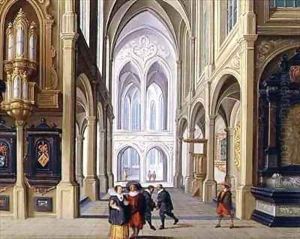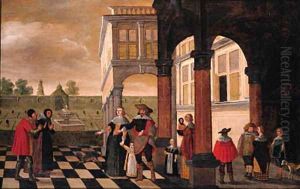Dirck van Deelen Paintings
Dirck van Deelen was a Dutch Golden Age painter, known for his skill in architectural painting, particularly church interiors and palatial structures. Born in Heusden, Netherlands, in 1605, van Deelen was a pivotal figure in the development of architectural painting in the 17th century. His works are characterized by their meticulous attention to detail, mastery of perspective, and the sophisticated use of light and shadow, which together create a realistic yet atmospheric depiction of space.
Van Deelen's early life is somewhat obscured, but it is known that he became a member of the painters' guild in Middelburg in 1632, indicating that his artistic training and early career were tied to this city, which was a vibrant center for art in the 17th century. His paintings often depicted the ornate interiors of Dutch churches, with their grand columns, arches, and intricate decorative elements, as well as fantasy palaces and courtyards, suggesting an imaginative mind that transcended the limitations of his provincial surroundings.
Throughout his career, van Deelen was influenced by the works of other architectural painters of his time, such as Hendrick van Steenwijk the Younger, with whom he shares a penchant for the dramatic use of light and shadow to enhance the three-dimensional effect of his compositions. However, van Deelen distinguished himself by his unique approach to these subjects, often incorporating figures into his architectural scenes to give them life and scale.
Despite his contributions to the Dutch Golden Age of painting, Dirck van Deelen did not gain the same level of fame as some of his contemporaries. Nevertheless, his work has been appreciated by art historians and collectors for its technical excellence and its atmospheric portrayal of architectural spaces. Van Deelen died in 1671, leaving behind a body of work that continues to be studied and admired for its contribution to the genre of architectural painting.

